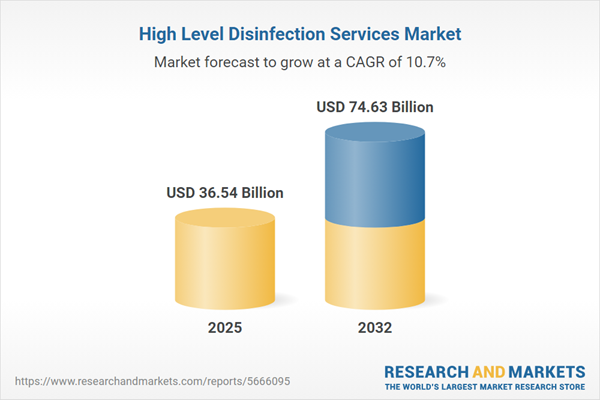Speak directly to the analyst to clarify any post sales queries you may have.
The high level disinfection services market is undergoing rapid transformation, driven by emerging technologies, shifting regulatory requirements, and increased demand for safe, efficient solutions across critical industries. As organizations face complex operational and compliance challenges, strategic investment in advanced disinfection protocols is now essential for long-term resilience and competitive advantage.
Market Snapshot: High Level Disinfection Services Market Overview
The High Level Disinfection Services Market grew from USD 33.06 billion in 2024 to USD 36.54 billion in 2025. It is projected to sustain strong growth at a CAGR of 10.71%, reaching USD 74.63 billion by 2032. Driven by technological innovation, adoption of digital monitoring, and rising safety standards, the sector is set for remarkable expansion. Healthcare, food processing, laboratory research, and pharmaceutical manufacturing remain leading demand drivers for high level disinfection services as they adopt sophisticated solutions to address evolving risks and compliance mandates.
Scope & Segmentation: Understanding Market Depth and Breadth
- End Users: Food processing, healthcare, laboratories, pharmaceutical manufacturers, and research institutions each present unique technical and regulatory challenges requiring tailored disinfection protocols.
- Service Types: Chemical services incorporate technologies such as formaldehyde, peracetic acid, and vaporized hydrogen peroxide, ensuring efficacy against resistant microorganisms. Non-chemical services include ozone, steam, and ultraviolet, offering alternative disinfection aligned with sustainability goals.
- Delivery Modes: Service providers deploy fixed systems for continuous, high-throughput environments, mobile vans for on-demand and remote scenarios, and portable systems for specialized or constrained spaces, ensuring operational flexibility across diverse client needs.
- Regions Covered: Extensive geographic analysis includes the Americas (United States, Canada, Mexico, Brazil, Argentina, Chile, Colombia, Peru), Europe (United Kingdom, Germany, France, Russia, Italy, Spain, Netherlands, Sweden, Poland, Switzerland), Middle East (United Arab Emirates, Saudi Arabia, Qatar, Turkey, Israel), Africa (South Africa, Nigeria, Egypt, Kenya), and Asia-Pacific (China, India, Japan, Australia, South Korea, Indonesia, Thailand, Malaysia, Singapore, Taiwan).
- Leading Companies: STERIS plc, Ecolab Inc., 3M Company, Johnson & Johnson, Getinge AB, Belimed AG, Contec Inc., Tristel plc, Metrex Research LLC, and ClorDiSys Solutions, Inc. have demonstrated notable advancements within the global disinfection services landscape.
Key Takeaways for Senior Decision-Makers
- Hospitals, food processors, and research environments prioritize tailored disinfection approaches to address patient safety, contamination control, and process integrity, influencing service adoption and future investment.
- The ongoing convergence of advanced material science, digital platforms, and data analytics is enabling service providers to deliver traceable, repeatable, and environmentally conscious disinfection processes.
- Hybrid disinfection solutions blending chemical and non-chemical technologies are gaining traction, as organizations seek both high efficacy and alignment with sustainability goals.
- End-to-end service offerings, which encompass maintenance, training, and performance validation, are increasingly demanded by clients seeking operational assurance and simplified vendor relationships.
- Organizations that establish strong partnerships with technology suppliers, equipment manufacturers, and industry specialists position themselves to capture emerging opportunities and navigate an evolving risk landscape.
- Cross-functional collaboration within organizations—linking operations, quality assurance, and IT teams—drives ongoing improvements in compliance, efficiency, and service quality.
Tariff Impact: Navigating Cost and Supply Uncertainty in 2025
Tariffs imposed by the United States in 2025 have created new hurdles for global supply chains in the high level disinfection space. Providers are re-evaluating procurement strategies, seeking domestic alternatives, negotiating discounts, and prioritizing supply chain resilience. These measures affect capital investments, technology adoption timelines, and risk-sharing across both large and small market participants.
Methodology & Data Sources
This report leverages comprehensive secondary research from peer-reviewed publications and regulatory documents, combined with direct interviews and structured surveys targeting key market stakeholders. Data points are validated through triangulation and strict editorial review, ensuring findings are both accurate and actionable for strategic planning.
Why This Report Matters
- Gives senior leaders data-driven insights to benchmark performance and identify best-practice disinfection models across critical industries.
- Supports informed technology investment, compliance readiness, and risk mitigation strategies in a volatile regulatory and economic climate.
- Enables decision-makers to anticipate emerging opportunities and threats, sharpening competitive positioning for sustained growth.
Conclusion
The high level disinfection services market is shifting rapidly as new technologies, regulatory requirements, and operational pressures converge. Organizations that embrace integrated solutions, invest in talent, and prioritize collaboration will be best positioned to enhance service quality, achieve compliance, and drive sustainable growth in a complex environment.
Additional Product Information:
- Purchase of this report includes 1 year online access with quarterly updates.
- This report can be updated on request. Please contact our Customer Experience team using the Ask a Question widget on our website.
Table of Contents
3. Executive Summary
4. Market Overview
7. Cumulative Impact of Artificial Intelligence 2025
Companies Mentioned
The companies profiled in this High Level Disinfection Services market report include:- STERIS plc
- Ecolab Inc.
- 3M Company
- Johnson & Johnson
- Getinge AB
- Belimed AG
- Contec Inc.
- Tristel plc
- Metrex Research LLC
- ClorDiSys Solutions, Inc.
Table Information
| Report Attribute | Details |
|---|---|
| No. of Pages | 189 |
| Published | October 2025 |
| Forecast Period | 2025 - 2032 |
| Estimated Market Value ( USD | $ 36.54 Billion |
| Forecasted Market Value ( USD | $ 74.63 Billion |
| Compound Annual Growth Rate | 10.7% |
| Regions Covered | Global |
| No. of Companies Mentioned | 11 |









